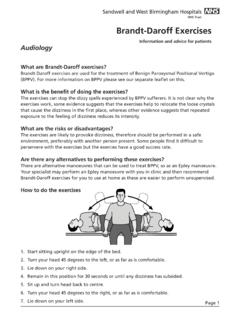The exercises should be performed three times each day. •encourage the use of proprioceptive activities above.


Vestibular rehabilitation exercises a fact sheet for patients and carers vestibular compensation vestibular compensation is a process that allows the brain to regain balance control and minimise dizziness symptoms when there is damage to, or an imbalance between, the right and left vestibular organs (balance organs) in the inner ear.



Vestibular exercises pdf nhs. Don’t worry if you seem to be stuck at an exercise for a week or more. Gaze stability exercise this is a type of exercise often given to patients with inner ear problems. Turn your head 45 degrees to the left, or as far as is comfortable.
L relaxing the neck and shoulder muscles l training the eyes to move independently of the head l practising good balance in everyday situations It helps to retrain the brain’s ability to adjust the balance problem and is known as compensation and adaption. Vestibular rehabilitation exercises are an aid to recovery and you should do them alongside an increase in your daily activities.
Www.uhs.nhs.uk vestibular migraine we have written this factsheet to give you more information about vestibular migraines. We hope you find this information useful however if you have any further questions about these exercises or any comments about this Nhs trust how to do the exercises 1.
Within the vestibular or balance system. Vestibular activities include any activity that moves the head in different planes e.g. Make sure that you are in a safe environment before you start any of the exercises to reduce the risk of injury.
The brain interprets information gained from the vestibular or balance system. Vestibular rehabilitation exercises this is a specific form of physiotherapy which may be suggested if your movements are very affected. Head positioned forward, downwards, tipped back, turning side to side, head tilt etc.
2 steps to follow when instilling ear drops. Iprescribe exercise iprescribe exercises provides users with a free 12 week personalised exercise programme. For more information on bppv please see our separate leaflet on this.
Please be aware that it may take a few days for you to get used to the exercises. Keeping head still, move eyes left to right 3. It plays a big part in our physiological arousal;
The vestibular system is stimulated by movement up or down, backward or forwards, and around or over. Sitting first, then when more confident, standing. When there is an injury or abnormality in any portion of this system, the brain must be retrained or taught to interpret correctly the information it receives.
The exercises can stop the dizzy spells experienced by bppv sufferers. Their use has been declining in recent years, as the home epley maneuver (see below) is considerably more effective. Keeping the head still, move eyes up and down 2.
The purpose of these exercises is to build up a tolerance mechanism and the more diligently and regularly they are carried out, the sooner the symptoms will disappear. Only carry these exercises out if advised by your therapist. Remain in this position for 30 seconds or until any dizziness has.
•soft , calm music played into ear phones may aid concentration and calm a child. •allow the child to carry out activities in a quiet environment at intervals throughout the day. Vestibular exercises merely stimulate the vestibular apparatus.
Exercises within the 10 minutes. • your exercises in a safe, comfortable, and relaxed environment • ask a family member or friend to act as a coach, if possible • wear either a low heel or no shoes for the standing exercises. This is the sensory system which is responsible for our sense of balance and movement, controlling our muscles, and most of our reflexes.
The treatment we recommend will depend on the cause of your child’s balance problem. They succeed in 95% of cases but are more arduous than the office treatments. Some children may benefit from performing specialist exercises to improve their balance, known as vestibular rehabilitation.
Focus on your index finger as you bring it from arm’s length away up It explains what a vestibular migraine is, what causes a migraine and how. To enable this to work fully, you will need to be dedicated to doing exercises regularly through
Www.uhs.nhs.uk patient information factsheet how are vestibular disorders treated? Exercises / manoeuvres suitable for self management of positional vertigo. Make sure the music is not played too loudly through the earphones.
• practice your exercises 3 times a day • continue your exercises even if they might make your dizziness worse for the first few days, this are normal • only move onto the next exercise when you have no dizziness doing the exercise before exercises when lying down: What is the benefit of doing the exercises? Current exercise evokes a ‘0’ on the scale, for 3 days in a row.
These exercises are based on normal movements that occur in daily life so they should be totally safe unless you have been advised to avoid these movements. Perform the exercises as directed above on each occasion. This should be performed in three sets of five, three times a day.
Start sitting upright on the edge of the bed. They succeed in 95% of cases but more arduous than the epley manoeuvre. Do not proceed with the other exercises until you are able to comfortably do the exercise in question without symptoms.
Vestibular and cawthorn cooksey exercises patient information university hospitals sussex nhs foundation trust. Activities to develop the vestibular system include: Lie down on your right side.
You should move on to the next exercise. Look up and down, slow at first, then rapidly 20 times. Vestibular input improves the muscles ability to work and improves balance/coordination.
Should an exercise make you feel off balance, dizzy or unstable, practice this exercise for the remainder of the 10 minutes. It is not clear why the exercises work, some evidence


















